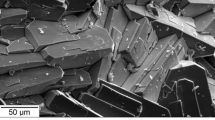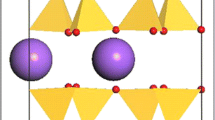Abstract
The hydroxyl orientations in 31 dioctahedral and trioctahedral 2:1 phyllosilicate structures have been determined by electrostatic energy calculations. These structures included micas, brittle micas, and other related minerals exhibiting ordered as well as disordered cation distributions. The dioctahedral micas and brittle micas were examined with and without the interlayer cation. A range of orientations from 1.3° to 183.3° (the angle ρ between the O-H and (001) measured with respect to the M1 site) were found. The orientations for the dioctahedral structures represent a continuum of values whereas the trioctahedral species exhibit two possible orientations separated by an energy barrier. One orientation is near 90° the other is near 180°. The latter orientation results from a concentration of charge on the interlayer (IC) and tetrahedral (T) sites at the expense of the octahedral (M) sites. A multiple regression analysis of all 31 structures, using as predictors the a and b cell parameters, d001, and the charges for T, IC, M1, and M2 sites, was performed. This analysis indicated that the important factors are the charges for IC, T, and M2 sites. When treated as a separate group, one finds the same factors for the dioctahedral structures. The trioctahedral orientations are determined by the charge on the M2 site and the amount of tetrahedral rotation. Using these two predictor equations, the value of ρ can be estimated with a standard deviation of 4.7° and 2.9° for the dioctahedral and trioctahedral cases, respectively.
Резюме
Ориентации гидроксила в 31 диоктаэдрической и триоктаэдрической структуре 2:1 листового силиката определялись путем вычислений электростатической энергии. Эти структуры включали слюды, Маргарит и другие родственные им минералы, характеризующиеся упорядоченным и не упорядоченным распределением катионов. Диоктаэдрические слюды и Маргарит исследовались при наличии и отсутствии межслойного катиона. Был обнаружен диапазон ориентаций от 1,3° до 183,3° (угол между О-Н и (001), измеренный по отношению к положению M1). Ориентации для диоктаэдрических структур неопределенны, в то время как триоктаэдрич еские образцы характеризуются двумя возможными ориентациями, разделенными энергетическим барьером. Одна ориентация близка к 90°; другая около 180°. Последняя ориентация является результатом концентрации зарядов в межслоях (ІС) и тетраэдрах (СТ) за счет октаэдров (М). Был выполнен многократный регрессионный анализ 31 структуры с использованием параметров а и b ячейки, d001, и зарядов для Т,ІС,М1, и М2. Этот анализ показал, что важными факторами являются заряды для ІС, Т, и М2. Если диокта- эдрические структуры рассматривать как отдельную группу, они также обнаруживают те же факторы. Триоктаэдрические ориен тации определяются зарядом на М2 и величиной вращения тетраэдров. С использованием этих двух предварительно полученных уравнений может быть определено значение ρ со стандартным отклонением 4,7° и 2,9° для случаев диоктаэдрических и триоктаэдрических структур соответственно.
Resümee
Die Hydroxylorientierungen in 31 dioktahedrischen 2/1 Phyllosilikatstrukturen sind durch elektrostatische Energiekalkulationen bestimmt worden. Diese Strukturen umfassen Glimmer, spröde Glimmer, und andere verwandte Mineralien, die sowohl geordnete wie nicht geordnete Kationenverteilungen aufweisen. Die dioktahedrischen Glimmer und brüchige Glimmer wurden mit und ohne Zwischenschichtkationen untersucht. Orientierungen von 1,3 bis 183,3° (der Winkel zwischen den OH und (001), gemessen mit Hinsicht auf den M1 Platz) wurden gefunden. Die Orientierungen für die dioktahedrischen Strukturen repräsentieren ein Kontinuum von Werten, wohingegen die trioktahedrischen Sorten zwei mögliche Orientierungen zeigen, die durch eine Energieschranke getrennt sind. Eine Orientierung ist fast bei 90°, die andere bei 180°. Die letztere Orientierung ist das Resultat einer Konzentration von Ladungen in den Zwischenschichtplätzen (IC) und den tetrahedrischen Plätzen (CT) auf Kosten der oktahedrischen Plätze. Eine multiple Regressionsanalyse aller 31 Strukturen wurde unternommen, indem die a und b Zellparameter, d001, und die Ladungen für die T, IC, M1, und M2 Plätze für Vorraussagungen benutzt wurden. Diese Analyse weist darauf hin, daß die wichtigen Faktoren die Ladungen für die IC, T, und die M2 Plätze sind. Wenn die oktahedrischen Strukturen als seperate Gruppen behandelt werden, findet man dort dieselben Faktoren. Die trioktahedrischen Orientierungen werden durch die Ladungen der M2 Plätze und die Höhe der tetrahedrischen Rotation bestimmt. Wenn diese zwei Vorraussagungsgleichungen benutzt werden, kann der Wert von ρ mit mittlerer Abweichung von 4,7 und 2,9° für die dioktahedrischen beziehungsweise trioktahedrischen Fälle bestimmt werden.
Résumé
Les orientations hydroxyles dans 31 structures dioctaèdres et trioctaèdres phyllosilicates 2:1 ont été déterminées par calcul de l’énergie électrostatique. Parmi ces structures il y avaient des micas, des micas cassants, et d’autres minéraux apparentés exhibant des distributions de cations ordonnées et désordonnées. Les micas dioctaèdres et les micas cassants ont été examinés avec et sans le cation interfeuillet. Un étagement d’orientations de 1,3° à 183° (l’angle entre l’OH et (001) mesuré par rapport au site M1) a été trouvé. Les orientations pour les structures dioctaèdres représentent une série continue de valeurs, tandis que les espèces trioctaèdres exhibent 2 orientations possibles séparées par une barrière d’énergie. Une orientation est près de 90°, et l’autre est près de 180°. Cette dernière orientation résulte d’une concentration de charge sur l’interfeuillet (IC) et sur les sites tétraèdres (T) aux dépens des sites octaèdres (M). Une analyse de régression multiple a été faite, utilisant comme pronostiquants les mailles paramètres a et b, d001 et les charges pour les sites T, IC, M1, M2, pour les 31 structures. Cette analyse a indiqué que les facteurs importants étaient les charges pour les sites T, IC, et M2. On trouve les mêmes facteurs pour les structures dioctaèdres si on les traite comme un groupe séparé. Les orientations trioctaèdres sont déterminées par la charge sur le site M2 et par la quantité de rotation tétraèdre. Une valeur pour ρ peut être estimée avec une déviation standard de 4,7° et 2,9° dans les cas dioctaèdres et trioctaèdres, respectivement, utilisant les équations pronostiquantes.
Similar content being viewed by others
References
Bailey, S. W. (1975) Cation ordering and pseudosymmetry in layer silicates: Am. Mineral. 60, 175–187.
Bassett, W. A. (1960) Role of hydroxyl orientation in mica alteration: Geol. Soc. Am. Bull. 71, 449–456.
Baur, W. H. (1972) Prediction of hydrogen bonds and hydrogen atom positions in crystalline solids: Acta Crystallogr. B28, 1456–1465.
Burnham, C. W. and Radoslovich, E. W. (1963) Crystal structures of coexisting muscovite and paragonite: Carnegie Inst, of Wash. Yearbook, 232–236.
Donnay, G. and Allmann, R. (1970) How to recognize O2, OH- and H2O in crystal structures determined by X-rays: Am. Mineral. 55, 1003–1015.
Donnay, G., Morimoto, N., Takeda, H., and Donnay, J. D. H. (1964) Trioctahedral one-layer micas. I. Crystal structure of a synthetic iron mica: Acta Crystallogr. 17, 1369–1373.
Giese, R. F. (1971) Hydroxyl orientation in muscovite as indicated by electrostatic energy calculations: Science 172, 263–264.
Giese, R. F. (1973) Hydroxyl orientations—dioctahedral micas: 10th Clay Minerals Society Meeting, Banff, Abstracts, 36.
Giese, R. F. (1975a) The effect of F/OH substitution on some layer-silicate minerals: Z. Kristallogr. 141, 138–144.
Giese, R. F. (1975b) Crystal structures of ideal, ordered one-layer micas: AFCRL-TR-75-0438, Environmental Research Papers, No. 526, 135 pp.
Giese, R. F. (1976) Hydroxyl orientations in gibbsite and bayerite: Acta Crystallogr. B32, 1719–1723.
Giese, R. F. (1977) The influence of hydroxyl orientation, stacking sequence, and ionic substitution on the interlayer bonding of micas: Clays & Clay Minerals 25, 102–104.
Giese, R. F. andDatta, P. (1973) Hydroxyl orientations in the muscovite polymorphs 2M1, 3T and 1M: Z. Kristallogr. 137, 436–438.
Gilkes, R. J., Young, R. C., and Quirk, J. P. (1972) The oxidation of octahedral iron in biotite: Clays & Clay Minerals 20, 303–315.
Guggenheim, S. and Bailey, S. W. (1977) The refinement of zinnwaldite-1M in subgroup symmetry: Am. Mineral. 62, 1158–1167.
Güven, N. (1971) The crystal structures of 2M1 phengite and 2M1 muscovite: Z. Kristallogr. 134, 196–212.
Güven, N. and Burnham, C. W. (1967) The crystal structure of 3T muscovite: Z. Kristallogr. 125, 163–183.
Hamilton, W. C. and Ibers, J. A. (1968) Hydrogen bonding in solids, W. A. Benjamin, Inc. New York, 284 pp.
Hazen, R. M. and Burnham, C. W. (1973) The crystal structure of one-layer phlogopite and annite: Am. Mineral. 58, 889–900.
Joswig, W. (1972) Neutronenbeugungsmessungen an einem 1M-Phlogopit: Neues Jahrb. Mineral. Monatsch. H1, 1–11.
McCauley, J. W. and Newnham, R. E. (1971) Origin and prediction of ditrigonal distortions in micas: Am. Mineral. 56, 1626–1638.
McCauley, J. W. and Newnham, R. E. (1973) Structure refinement of a barium mica: Z. Kristallogr. 137, 360–367.
McCauley, J. W., Newnham, R. E., and Gibbs, G. V. (1973) Crystal structure of synthetic fluorophlogopite: Am. Mineral. 58, 249–254.
Meier, W. M. and Villiger, H. (1969) Die Methode der Abstandsverfeinerung zur Bestimmung der Atomkoordinaten idealisierter Gerüststrukturen: Z. Kristallogr. 129, 411–423.
Prost, R. (1975) Interactions between adsorbed water molecules and the structure of clay minerals: Hydration mechanism of smectites: Proc. Int. Clay Conf., Mexico City, 351–359.
Raynor, J. and Brown, G. (1973) The crystal structure of talc: Clays & Clay Minerals 21, 103–114.
Rothbauer, R. (1971) Untersuchung eines 2M1-Muskovits mit Neutronenstrahlen: Neues Jahrb. Mineral. Monatsch. H4, 143–154.
Sartori, F., Franzini, M., and Merlino, S. (1973) Crystal structure of a 2M2 lepidolite: Acta Crystallogr. B29, 573–578.
Serratosa, J. M. and Bradley, W. F. (1958) Determination of the orientation of OH bond axes in layer silicates by infrared absorption: J. Phys. Chem. 62, 1164–1167.
Soboleva, S. V. and Zvyagin, B. B. (1969) Crystal structure of dioctahedral Al-mica 1M: Sov. Phys. Crystallogr. 13, 516–519.
Steinfink, H. (1962) Crystal structure of a trioctahedral mica; phlogopite: Am. Mineral. 47, 886–896.
Takeda, H. and Burnham, C. W. (1969) Fluor-polylithionite; a lithium mica with nearly hexagonal (Si2O5)2− ring: Mineral. J. Jpn. 6, 102–109.
Takeda, H. and Donnay, J. D. H. (1966) Trioctahedral one-layer micas. III Crystal structure of a synthetic lithium fluormica: Acta Crystallogr. 20, 638–646.
Takeda, H., Haga, N., and Sadanaga, R. (1971) Structural investigation of polymorphic transition between 2M2-, 1M-lepidolite and 2M1 muscovite: Mineral. J. Jpn. 6, 203–215.
Takeda, H. and Ross, M. (1975) Mica polytypism: dissimilarities in the crystal structures of coexisting 1M and 2M1 biotite: Am. Mineral. 60, 1030–1040.
Takeuchi, Y. (1965) Structure of brittle micas: Clays & Clay Minerals 13, 1–25.
Tateyama, H., Shimoda, S., and Sudo, T. (1974) The crystal structure of synthetic MgIV mica: Z. Kristallogr. 139, 196–206.
Tsuboi, M. (1950) On the positions of the hydrogen atoms in the crystal structure of muscovite, as revealed by the infrared absorption study: Bull. Chem. Soc. Jpn. 23, 83–88.
Vedder, W. and McDonald, R. S. (1963) Vibrations of the OH ions in muscovite: J. Chem. Phys. 38, 1583–1590.
Wardle, R. and Brindley, G. W. (1972) The crystal structures of pyrophyllite, 1Tc, and of its dehydroxylate: Am. Mineral. 57, 732–750.
Zhoukhlistov, A., Zvyagin, B. B., Soboleva, A. V., and Fedotov, A. F. (1973) The crystal structure of the dioctahedral mica 2M2 determined by high voltage electron diffraction: Clays & Clay Minerals 21, 465–470.
Author information
Authors and Affiliations
Rights and permissions
About this article
Cite this article
Giese, R.F. Hydroxyl Orientations in 2:1 Phyllosilicates. Clays Clay Miner. 27, 213–223 (1979). https://doi.org/10.1346/CCMN.1979.0270307
Received:
Accepted:
Published:
Issue Date:
DOI: https://doi.org/10.1346/CCMN.1979.0270307




